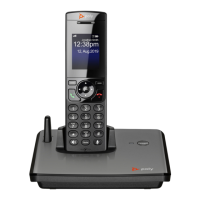Service Providers
48
The intervals for checking the primary fallback list and the secondary fallback list are configured in the
X_CheckPrimaryFallbackInterval and X_CheckSecondaryFallbackInterval parameters. These
parameters are specified in seconds and the default value is 60 for both.
Notes:
● Existence of a secondary server implies a primary server exists.
● If the secondary server exists, it immediately becomes the primary server when the current primary
server fails. The device then starts searching for a new secondary server if the candidate set isn’t
empty.
● The candidate list can change (be lengthened, shortened, have its priority changed, and so forth) on
every DNS renewal (based on the entry’s TTL). The device rearranges the primary and secondary
servers and fallback lists accordingly, whichever applies.
If the server redundancy feature is disabled, the device resolves only one IP address from the server’s
domain name, and won’t try other IP addresses if the server isn’t responding.
SIP Privacy
The device observes inbound caller privacy and decodes caller’s name and number from SIP INVITE
requests by checking the FROM, P-Asserted-Identity (PAID for short), and Remote-Party-ID (RPID for short)
message headers. All these headers can carry caller’s name and number information.
If PAID is present, device takes the name and number from it. Otherwise, it takes the name and number from
RPID if it is present, or from the FROM header otherwise. RPID, if present, includes the privacy setting
desired by the caller. This privacy can indicate one of the following options:
● off = no privacy requested. The device shows name and number.
● full = full privacy requested. The device hides both name and number.
● name = name privacy requested. The device shows the number but hides the name.
● uri = uri privacy requested. The device shows the name but hides the number.
Regardless, if PAID exists or not, the device always takes the privacy setting from the RPID if it’s present in
the INVITE request. Note that if the resulting caller name is “Anonymous” (case-insensitive), device treats
it as if the caller is requesting full privacy.
For outbound calls, caller’s preferred privacy setting can be stated by the device in a RPID header of the
outbound INVITE request. To enable this behavior, the ITSP Profile X – SIP::X_InsertRemotePartyID
parameter must be set to YES or TRUE, which is the default value of this parameter. The device supports
only two outbound caller privacy settings: privacy=off or privacy=full. The RPID header generated by the
device carries the same name and number as the FROM header. If outbound caller-ID is blocked, the device
sets privacy=full in RPID, and also sets the display name in the FROM and RPID headers to “Anonymous”
for backward compatibility. The device won’t insert PAID in outbound INVITE requests.
STUN and ICE
The device supports standard STUN based on RFC3489 and RFC5389 for passing inbound RTP packets
to the device sitting behind NATs. The parameters that control the STUN feature are found in the ITSP
Profile X – General:: section:
● STUNEnable – Enables this feature (default is NO or FALSE).
● STUNServer – The IP address or domain name of the external STUN server to use. STUN feature is
disabled if this value is blank, which is the default.

